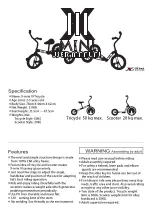
5
not touch the body above, below or on the side. If necessary, shorter cranks, other pedals or
shoes must be fitted. The seating position must be chosen so that you can safely see over the
edge of the body to the front. Are all controls set correctly and can they be operated without
any problems?
It is important that the steering pivot lever is firmly clamped to the steering column pin so that
the steering can never slip. You can access the clamping screw through the service opening
under the vehicle.
Check the central screw on the mono swing-arm. This screw clamps the rear wheel on the axle
and must be secured with safety screw varnish.
Check whether the rear shock absorber is screwed tight.
3. While driving
Please note the rules set out in the sections above. If you notice anything strange while driving,
anything seems loose, or you hear a suspicious noise, stop and inspect the vehicle.
Keep in mind that the braking distance increases disproportionately at high speeds. In
particular, avoid driving through potholes or over train tracks at high speeds. Remember, the
Bülk MK1 is an ultra-light vehicle and can be damaged if subjected to excessive loads.
The vehicle has derailleur gears. You can only change gears if you pedal along when shifting
(without strong force). Attention: if you roll backwards or push backwards and the rear
derailleur is not positioned correctly (e.g. because you shifted while stationary), the chain can
jam with the rear derailleur and cause damage. Stop the backward movement immediately if
you feel resistance or hear a suspicious noise. Since the chain is not guided during return, it
can jump off and get jammed. Never force yourself backwards if you feel resistance. Only drive
off with a safely engaged gear.
4. Information on the special features of the vehicle
The Bülk MK1 offers many advantages over a normal single-track bicycle when it comes to safety in
city traffic and on long tours. This includes effective rollover support, an effective restraint system
through the coaming and a stable body that offers good protection in the event of a fall.
Nevertheless, there are some things that should be considered.
4.1 Brakes
The standard-braking system of the Bülk MK1 is not designed for larger mountains, i.e. the drum
brakes can overheat on longer descents and temporarily lose their effectiveness. Since you can easily
reach very high speeds with the Bülk MK1 even on small gradients due to its excellent aerodynamics,
it is important that you as a driver approach the braking properties of the Bülk MK1. The braking
distance is also heavily dependent on the load and the weight of the driver.
There are the standard drum brakes (70 mm) or the 90 mm brakes for mountainous terrain. The strong
brakes can also be retrofitted.
Do not brake on descents by constantly pulling the brakes, but with short, powerful brake bursts. Do
not allow high speeds when descending if you have to brake hard before the next bend anyway.


































